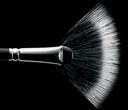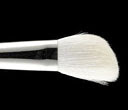

Cleaning Brushes - First Use
First use cleaning tools
- Tissues or paper towel.
- Brush cleanser
Brushes that are purchased brand-new come with several glues and fixatives sprayed onto the bristles to keep them in shape during transit. It's strongly suggested that you remove these glues before using your brushes. 'Break' the glue on the bristles with your finger, then squirt some brush cleanser onto a paper towel and gently pat the brush onto the moist towel until it becomes soft, pliable and damp. Set aside to dry, then feel if the brush still feels stiff and unyielding. If so, repeat the cleansing process. If it feels soft(er) and pliable, then it's ready to use.
Cleaning Brushes - Spot Cleaning
Spot cleaning tools
- Tissues or paper towel.
Spot cleaning tools
- Tissues or paper towel.
- Brush cleanser
Give a generous squirt of brush cleanser onto a tissue or paper towel, then stroke your dirty brush back and forth through the cleanser. Keep doing this until the brush doesn't leave behind any coloured marks, every now and then dabbing the brush on a clean and dry section of tissue. Set aside on a paper towel to dry fully before using. Some white bristled brushes like the 187 Duo Fibre brush may look faintly creamy or slightly off-white even after thoroughly spot cleaning. This is normal. Do not swirl or soak the brush with cleanser, as this may lead to shedding.
Cleaning Brushes - Deep Cleaning and Conditioning
Deep cleaning tools
- Basin of cool-to-tepid water
Cleaning Brushes - Deep Cleaning and Conditioning
Deep cleaning tools
- Basin of cool-to-tepid water
- Basin of cold water
- Baby shampoo, unscented
- Paper towels
Put a generous squirt of baby shampoo into the bowl of tepid water and mix thoroughly (N.B. I also add a small splash of Dettol, a medical-grade disinfectant for extra hygiene insurance, but this is completely optional and requires extra rinsing afterwards). Take your dirty brush and dampen the bristles in the water, being careful not to let the metal ferrule or handle get wet. Fluffier brushes absorb water quicker than denser brushes, so be mindful not to saturate the brush. Gently pat the brush against the side of the basin until no more make-up detritus appears*, then quickly swish the bristles in the basin of cold water to rinse. Repeat if required. Baby shampoo contains mild conditioning agents, so there is no need to use an extra conditioning product.
Lay the brushes out to dry on paper towels in a cool, dry spot. It's important that the bristles are kept lower than the ferrule and handle in order to prevent water seeping into the glue that holds the bristles, ferrule and handle together. As the brushes dry, gently reshape with your fingers. * Some black-bristled brushes, particularly powder and blush brushes, will release black dye for months or years after purchasing, even with regular washing. It's completely normal and won't affect your powders or blushes.